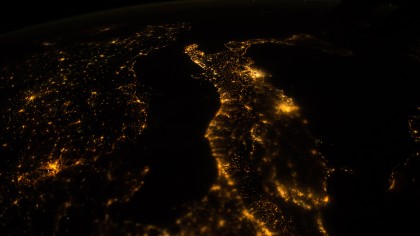Forget Gravity, this IMAX movie was filmed in space for real
We sat down with Toni Myers to discuss the challenges of filming her most ambitious documentary yet
This incremental feedback was an important part of helping the crews, which were made up of scientists and engineers and not filmmakers, to become comfortable with shooting in conditions that would challenge even seasoned camera operators.
VR planning
Occasionally however, a one-time event would take place that the team couldn't afford to not get right first time. This was when Myers turned to the virtual reality facilities at the Jonathan Space Centre, which enabled her to place a virtual camera on the space station and plan shots with a startling degree of accuracy.
This meant that when such an event occurred, such as the docking of the Russian Soyuz shuttle with the station, the camera settings, angles, and lenses could all be decided weeks in advance, allowing the crew to focus on completing the mission rather than filming.
Analogue troubles
It's clear that the use of digital cameras played a huge part in making the filming of A Beautiful Planet possible – which makes it all the more remarkable that Myers was able to use real film during the production of Hubble 3D in 2010, and Space Station 3D in 2002.
Hubble 3D saw a whole mile of IMAX film flown up to the Hubble Telescope to document its repair, but all that film was only able to produce eight minutes of footage. It then had to be returned to Earth before anyone could know whether the footage was worthwhile.
In contrast, the crew of the ISS was able to send piecemeal footage to Myers throughout their time with the cameras, simply by transmitting the data to Earth.
Myers is candid about the opportunities digital film opened up to her. "You'll hear many people protecting film, which is great for artistic applications, [it's] more nuanced – but boy digital's great."
Sign up for breaking news, reviews, opinion, top tech deals, and more.
The change in camera technology also allowed for the inclusion of night shots in A Beautiful Planet, which were previously impossible to capture due to the slow speeds of film, and thanks to the advent of digital 4K cameras none of the resolution of IMAX film was lost.

One such shot, of the moonlit coral reefs around the Bahamas, is especially stunning, while another shows Europe lit up at night by thousands of miles of highways. But the most rewarding aspect of going digital has to be that it enables us to see the stars, which when recorded on film disappeared into the blackness of space.
Dual messages
The documentary switches between these epic exterior shots and more intimate interior shots of the crew that man the ISS, and the themes of the movie are similarly two-track.
On the one hand you have an environmental message about the state of the planet, with breathtaking shots of the Himalayas tinged by the knowledge that their ice caps are melting due to climate change.
But the film is also a celebration of the accomplishments of humanity in surviving in space. We see astronauts managing to grow lettuce in zero gravity, and having to overcome massive hurdles to exercise, and avoid their muscles wasting away.

Ultimately these two themes come together to paint an enormously optimistic picture of our planet's future, with the hope that science and human ingenuity will help us overcome the environmental challenges ahead.
But what's next for Toni Myers?
"I'm just starting to breath out with the end of the this," she says. "I've been telling people I think I'm going to go home and be a grandmother now." If Hubble and Space Station are anything to go by, however, she'll likely have her cameras back in the hands of astronauts before too long.
A Beautiful Planet will be released today in selected cinemas across the UK, and in the US on Sunday. Unfortunately Australian space fans will have to wait until September to catch A Beautiful Planet when it releases there.

Jon Porter is the ex-Home Technology Writer for TechRadar. He has also previously written for Practical Photoshop, Trusted Reviews, Inside Higher Ed, Al Bawaba, Gizmodo UK, Genetic Literacy Project, Via Satellite, Real Homes and Plant Services Magazine, and you can now find him writing for The Verge.